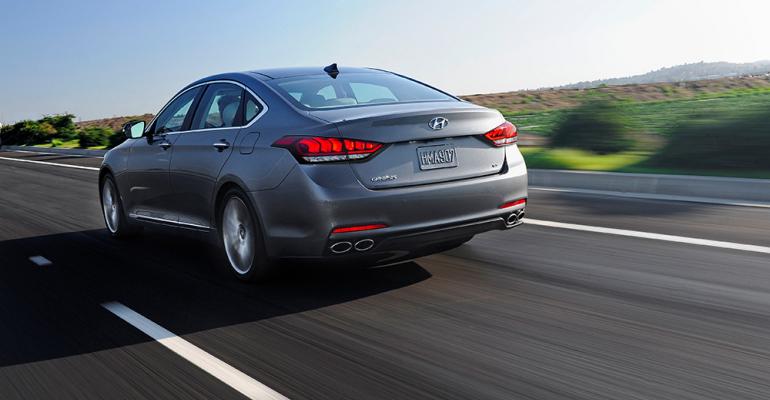WEST BLOOMFIELD, MI – Hyundai Motor America President and CEO Dave Zuchowski says technology inside the redesigned ’15 Genesis puts an exclamation point on the sedan’s statement in the luxury segment.
“There is so much technology in that car,” he says. “That is the real story.”
Hyundai shook up the luxury segment in 2008 with the first-generation Genesis, proving the seller of budget-leaning small cars and CUVs could design and engineer a competitive, V-8-powered rear-wheel-drive luxury sedan.
The V-8 engine in the Genesis garnered three Ward’s 10 Best Engines awards, as well as a slew of other recognitions including the 2009 North American Car of the Year and a spot on the coveted recommended list at Consumer Reports magazine.
But these days performance takes a vehicle only so far in the luxury segment, where consumers now expect a long list of advanced safety items and driver-assist technologies.
“That is where the segment is going,” Zuchowski tells WardsAuto in an interview here.
So that’s where Hyundai took the latest Genesis.
It offers advanced safety technologies such as automatic emergency braking; adaptive cruise control capable of taking the car to a full stop and then back up to speed; a combination of blindspot detection, rear cross-traffic alert and lane-change assist to avoid vehicles approaching quickly from behind; lane-departure warning and lane-keeping assist; a full-color heads-up display with a segment-first lane-departure warning icon; and a carbon-dioxide sensor to prevent drowsy driving.
The safety equipment helped the Genesis gain designation as a “Top Safety Pick +” from the Insurance Institute for Highway Safety.
New creature features include high-beam headlamp assist, hands-free access to the trunk, Apple “Eyes Free” Siri integration, wireless Internet access and a segment-leading 9.2-in. (23-cm) high-definition color infotainment display for media and vehicle information.
Other notable features include a second-generation BlueLink safety and security system with remote-start capability and a navigation system powered by Google.
The technologies come available at a fraction of the cost of most German luxury sedans. Well-equipped V-8 models, for example, enjoy a $20,000 price advantage over the ’14 BMW 550i, according to Hyundai.
“Not everybody has this array of safety and features, and certainly not with this value proposition,” Zuchowski says.
Many of the advanced safety technologies, such as adaptive cruise control and lane keeping, are precursors to autonomous driving, and Zuchowski says Hyundai’s approach to packaging them has caught the eyes of U.S. regulators.
“They love where we’re going, and we feel we’re ahead of the game,” he says.
Genesis engineers did not back away from traditional pillars of the luxury segment, either, such as adding aluminum parts to save weight and improve driving performance; further buttoning down the engine compartment for better noise, vibration and harshness qualities; redesigning the suspension for tighter driving dynamics; and switching to a motor-driven electronic power-steering system to enhance responsiveness.
The extra content adds about 100 lbs. (45 kg) to the car’s curb weight, but fuel economy for both the 3.8L V-6 and 5.0L V-8 engines improves.
One interesting omission from the ’15 Genesis is an all-wheel-drive option for V-8 models. That means stay tuned for a potential performance model with AWD in the next couple of years.
“We’re not commenting, but don’t be surprised,” Zuchowski says coyly. “Watch this space.”





